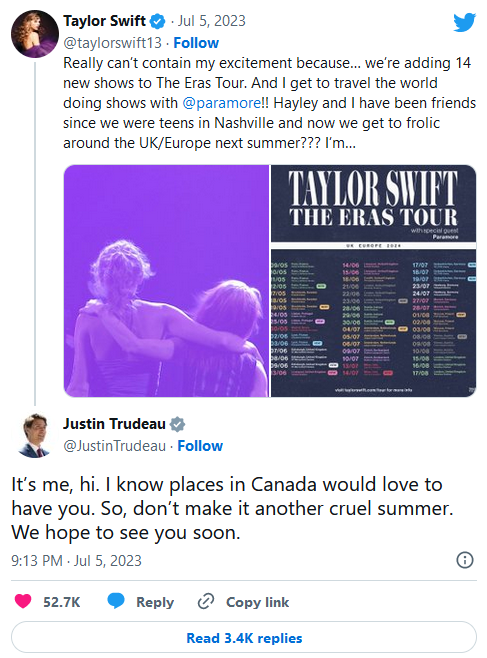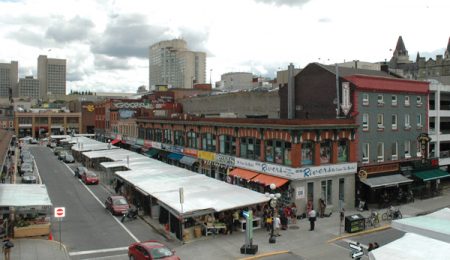“North-American tours” never seem to come far enough North
People across Canada feel slighted. While making a full return to touring post-COVID-19, artists seem to have completely forgotten about the country north of the United States. It’s gotten so bad that Prime Minister Justin Trudeau, himself, felt the need to step in; he tweeted at Taylor Swift in early July asking her to add dates in Canadian cities to her Eras Tour.
What gives?
When artists do come to Canada, it feels like a the-stars-are-aligning, once-in-a-lifetime event. In some ways, it is.
Kevin Donnelly is the senior vice president of venues and entertainment at True North Sports and Entertainment, the company that owns the Winnipeg Jets and their 16,345-capacity arena. He explained some factors to iHeart Radio.
Although Donnelly wasn’t involved in the tour, he knows tour managers expect Canadian fans to cross the border to nearby U.S. cities like Detroit or Seattle to attend the Eras Tour. Donnelly said, “[the] combination of the money available through the size of your venue, the currency you’re going to pay in, and the availability of that venue and the schedule of that performer” are the main factors that go into determining tour stops.
In Swift’s case, her U.S. shows have been held exclusively at NFL stadiums. The smallest of them, the Pittsburgh Steelers’ Acrisure Stadium, holds 68,4000, plus added floor seating for concerts. In comparison, Edmonton’s Commonwealth Stadium holds 56,302 for CFL games as Canada’s largest venue.
The Toronto Star had another take on the financial side of touring: knowing Eras Tour tickets are already selling for hundreds of dollars and reselling for thousands, high-profile artists can’t balance profits with “unfavourable exchange rates…without a significant hike to ticket prices”.
International artists don’t need special visas in order to work across the border, beyond spending extra time at the border, the process is simple for musicians performing at music venues (though that isn’t true for those performing at restaurants and bars).
Swift’s good friend Ed Sheeran has already stopped in six Canadian provinces this summer. Sorry to the Maritimes, but we have to consider that as covering Canada.
But, a lot of those Canadian stops came as add-ons to Sheeran’s prior stadium tour plans. In April, he announced he would essentially be running two tours simultaneously. The Mathematics Tour includes stops in 50,000-capacity stadiums in both Toronto’s Rogers Centre and Vancouver’s BC Place.
Sheeran’s other shows in Canada were part of the Subtract Tour, performances at much smaller venues in the days between Mathematics’ stops. In Toronto, Sheeran played at the 2,500-person venue History before selling out two nights at the 50,000-capacity Rogers Centre.
A lack of viable venues is a main reason why touring artists don’t come to Canada, so the effort to perform at smaller venues made the stops in Quebec City, Winnipeg and Saskatoon possible.
Ottawa, the forgotten capital
Even on a cross-Canada tour, Sheeran still didn’t stop in the capital. Those aforementioned cities have the advantage of distance or isolation.
The music blog Beat dove into why artists avoid bringing their tours to Ottawa.
With the capital sitting roughly between Canada’s two biggest cities (and most popular tour stops), Kyle Stumpo explains, “many acts don’t want to spend the extra money on a venue in Ottawa if people can just use a car, train or plane to get to Montreal or Toronto in a half decent amount of time”. Even the drive from Quebec City to Montreal is longer than the drive from Ottawa to Montreal.
On top of that, Ottawa’s venues aren’t a good fit for busy artists. Through the winter, the 20,500-person Canadian Tire Centre works around the Ottawa Senators’ schedule. Through the summer, the bigger 24,000-person outdoor TD Place Stadium hosts football and soccer games.
Even if they aren’t being used by a sports team, switching a hockey arena or football or soccer field to a concert venue takes a lot of time, people, and money.
As for non-stadium artists, Ottawa is currently missing a good mid-size venue (think: 1,500–2,000). There’s hope though, since a mid-size music venue is officially on the new night commissioner’s agenda.
It’s unfortunate, but the saddest thing is probably the feeling that comes when Canadians realize that an artist’s “North American tour” contains, at best, one or two Canadian dates.





